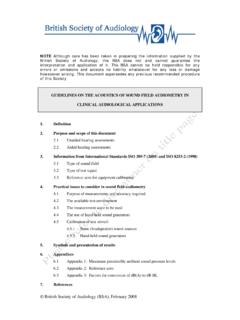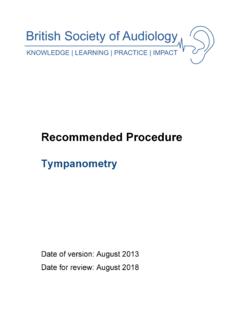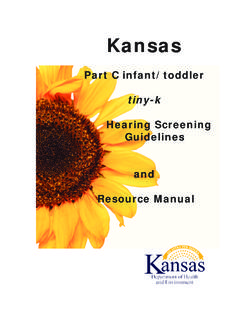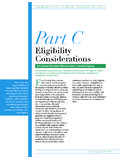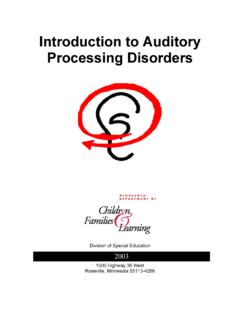Transcription of Visual Reinforcement Audiometry - BSA
1 Recommended Procedure Visual Reinforcement Audiometry Date: June 2014 Date for review: June 2019 Recommended procedure British Society of Audiology Visual Reinforcement Audiometry 2014 BSA 2014 2 General foreword This document presents a Recommended Procedure by the British Society of Audiology (BSA). A Recommended Procedure provides a reference standard for the conduct of an audiological intervention that represents, to the best knowledge of the BSA, the evidence-base and consensus on good practice given the stated methodology and scope of the document and at the time of publication.
2 Although care has been taken in preparing this information, the BSA does not and cannot guarantee the interpretation and application of it. The BSA cannot be held responsible for any errors or omissions, and the BSA accepts no liability whatsoever for any loss or damage howsoever arising. This document supersedes any previous recommended procedure by the BSA and stands until superseded or withdrawn by the BSA. Comments on this document are welcomed and should be sent to: British Society of Audiology 80 Brighton Road, Reading Berkshire, RG6 1PS, UK Published by the British Society of Audiology British Society of Audiology, 2014 All rights reserved.
3 This document may be freely reproduced for educational and not-for-profit purposes. No other reproduction is allowed without the written permission of the British Society of Audiology. Please avoid paper wastage, by using double-sided ( duplex ) printing. Recommended procedure British Society of Audiology Visual Reinforcement Audiometry 2014 BSA 2014 3 1. Contents 2. Introduction .. 4 3. Scope .. 4 4. Competency and skills .. 5 5. Facilities and preparation .. 5 Test environment, set-up and equipment.
4 5 Type of Reinforcement : illuminated and animated toys .. 7 Positioning of the loudspeakers .. 7 Position of reinforcers .. 7 Positioning of child and tester .. 8 Position of tester in observation room .. 8 Communication between testers .. 8 Hearing protection .. 9 6. Stimuli .. 9 Stimulus type .. 9 Stimulus delivery .. 10 Precautions against cross infection .. 10 Calibration .. 10 7. Test procedure .. 11 Subject preparation.
5 11 Procedure for measurement of minimum response levels .. 12 Initiation of test and role of Tester 2 .. 12 Familiarisation and conditioning .. 12 Testing .. 13 Tips for effective VRA testing .. 15 The most common pitfalls of VRA testing .. 15 Testing children with vision disorders, with other disabilities or at an early age .. 16 Sequence and objectives of assessment .. 17 8. Interpretation of results .. 18 Sound-field .. 18 Insert earphones.
6 19 Bone conduction .. 20 9. Recording and reporting of results .. 20 10. References .. 22 Appendix A. Authors and acknowledgments .. 23 Appendix B. Definitions .. 24 Appendix C. Suggested single-room layout .. 25 Appendix D. Symbols .. 25 Recommended procedure British Society of Audiology Visual Reinforcement Audiometry 2014 BSA 2014 4 2. Introduction This document is a revision of the protocol produced by the Newborn Hearing Screening Programme (NHSP, 2008); the revision was conducted by the BSA Professional Practice Committee (see Appendix A).
7 As with NHSP s version, the content here is guided by evidence where possible. However, there is insufficient research in this area and recommendations in this document are based on the opinion or reported practice of experts in the field. General references that have guided the content of this document are provided and specific references have been stated where considered helpful. We welcome further research in this area. Visual Reinforcement Audiometry (VRA) is a key behavioural test for young children.
8 It is central to completion of the diagnostic process for those hearing-impaired infants identified by newborn screening. Furthermore, contemporary paediatric amplification fitting methods rely on solid foundations of measurement to ensure the validity and reliability of hearing aid fitting. It is hoped that the standardised VRA technique described here will facilitate training of Audiologists and be of use in research studies. There are many points of debate relating to set-up and methodology for this test technique and it is recognised that alternative approaches exist some aspects of the technique.
9 However, a decision was taken to adopt the particular approach described here for the purposes of standardisation. It is advised that only experienced Audiologists (or those led by such colleagues) should consider deviating from this protocol. Appendix B provides a definition of terms. 3. Scope The document sets out to provide guidelines for testing babies with a minimum developmental age of 5 7 months. The test is suitable for infants who are able to sit unsupported or with minimal support and able to turn their head side to side.
10 It is assumed that the reader of this document is familiar will the principles of VRA. This protocol covers only VRA, including the defining feature of one-sided Reinforcement (rather than two-sided Reinforcement of the conditioned orientation response test). VRA is the accepted standard audiological assessment method for children that can be conducted with reliability from a developmental age of 8 9 months onwards (Day et al. 2000). The document covers the technical procedure of carrying out a manual VRA test, equipment/environment considerations, basic interpretation of the results, reporting and patient handling procedures relevant to the test.

